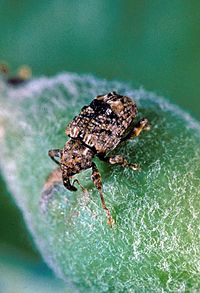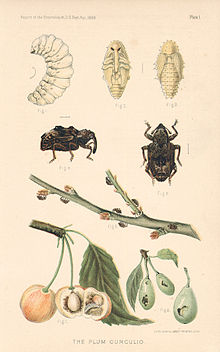Plum curculio
| Plum curculio | |
|---|---|

| |
| Scientific classification | |
| Domain: | Eukaryota |
| Kingdom: | Animalia |
| Phylum: | Arthropoda |
| Class: | Insecta |
| Order: | Coleoptera |
| Family: | Curculionidae |
| Genus: | Conotrachelus |
| Species: | C. nenuphar
|
| Binomial name | |
| Conotrachelus nenuphar (Herbst, 1797)
| |
The plum curculio (Conotrachelus nenuphar) is a true weevil native to the regions east of the Rocky Mountains in the United States and Canada. It is notorious for destroying fruits if left uncontrolled.


Life stages
[edit]A female curculio uses a number of hosts to lay her eggs in, including plums, peaches, apples, pears, and other pome and stone fruits. After the female has chosen a suitable host, she will build an egg chamber under the fruit skin to receive the egg. She then turns around and places the egg in the cavity. Next, she slices a curved slit underneath the egg cavity, leaving the egg in a flap of flesh and causing a crescent-shaped scar on the outside of the fruit. Without this curved slit, eggs are killed by pressure from the growth of the host fruit.
Appearance
[edit]Plum curculio larvae are typically 6 to 9 mm long when fully grown, when they reach the pupal stage measuring about 5 to 7 mm; all adult characteristics are visible in this stage prior to transformation. Adult plum curculio are about 4 to 6 mm long and have a small, rough snout colored with black, gray, and brown specks. Four pairs of ridges cover the wings; however, because of the middle humps they appear to have only two ridges.
Hosts
[edit]The plum curculio can be found in apple, nectarine, plum, cherry, peach, apricot, pear and quince. It may also survive on wild plum, hawthorn, and crabapple. Females may oviposit on other plants, regardless of if the beetle larvae can survive on them. [1] It is found most commonly in areas east of the Rocky Mountains and in eastern Canada. The beetles are most active during the spring time when the weather is warm, damp, and cloudy. They are often seen in heavy leafed trees, and overwinter in woods.[2]
Injury or damage to fruit
[edit]Plum curculio beetles can cause irreparable damage to a fruit harvest. In badly damaged fruit, one can identify large scars and bumps due to feeding. Most internally damaged fruit (through burrowing into the fruit) drops prematurely.
Control
[edit]Control of the plum curculio is fairly easy to maintain. Traps, often containing benzaldehyde, can be used to determine the presence of the plum curculio in an orchard. [2] Application of proper insecticide during the pink and petal-fall stages of apples, also the petal-fall and shuck-split stages in peaches and cherries is usually enough to reduce plum curculio damage to a minimum. An important preventative measure is destroying the fallen, damaged host fruits before the adults emerge. Pest management at petal fall is also of particular importance.
References
[edit]- ^ Jenkins, David; Cottrell, Ted; Horton, Dan; Hodges, Amanda; Hodges, Greg (1 February 2006). "Hosts of Plum Curculio, Conotrachelus nenuphar (Coleoptera: Curculionidae), in Central Georgia". Environmental Entomology. 35 (1): 48–55. doi:10.1603/0046-225X-35.1.48.
- ^ a b Prokopy, Ronald J.; Chandler, Bradley W.; Dynok, Sara A.; Piñero, Jaime C. (1 June 2003). "Odor-Baited Trap Trees: A New Approach to Monitoring Plum Curculio (Coleoptera: Curculionidae)". Journal of Economic Entomology. 96 (3): 826–834. doi:10.1093/jee/96.3.826.
External links
[edit] Data related to Plum curculio at Wikispecies
Data related to Plum curculio at Wikispecies- Pest Management Laboratory MSU - plum curculio
- Ohio State University Extension fact sheet - plum curculio and its control
- Michigan State University Extension fact sheet - plum curculio
- University of Kentucky Entomology - plum curculio
- Bugguide.net. Species Conotrachelus nenuphar - Plum Curculio
Text is available under the CC BY-SA 4.0 license; additional terms may apply.
Images, videos and audio are available under their respective licenses.
